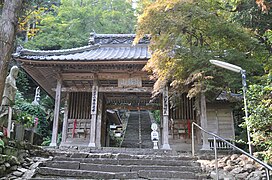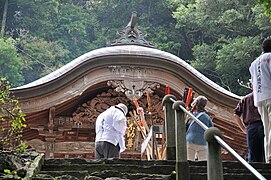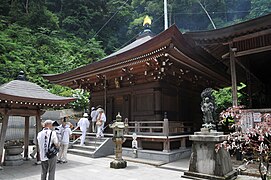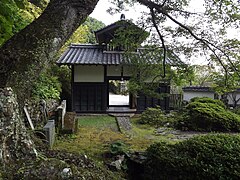Shōryū-ji (Tosa)
The Shōryū-ji ( Japanese (青 竜 寺) ), with the Go Dōkozan ( 独 鈷 山 ) and Ishanain ( 伊 舎 那 院 ) in the city of Tosa ( Kōchi Prefecture ), is a temple of the Buzan branch ( 豊 山 派 ) of Shingon Buddhism . In the traditional count, it is the 36th temple on the Shikoku pilgrimage route .
history
Priest Kūkai , returned from China in 806, where he had been instructed in esoteric Buddhism by Priest Huiguo ( 恵 果 ; 746-806), went on a pilgrimage around Shikoku. In 816 he reached the tip of the elongated peninsula off Tosa by boat and built a temple there, donated a Fudō Myōō and named the temple "Shōryū-ji" after the temple of his Chinese teacher.
Until the Meiji period , the Shōryū-ji with the sub-temple Nishigadera ( 西 ヶ 寺 ) and six Klausen belonged to the "seven great temples of Tosa". The Fudō, venerated in the temple, is also called " Wave- dividing Fudō" ( 波切 不 動 , Nakiri Fudō Mōō ). When Kūkai got caught in a storm on the crossing to China, a fudō is said to have appeared to him, which calmed the sea. Even today the fishermen in the area come to the temple to ask for safety at sea.
investment
The temple complex is divided into two parts: the abbey, a three-story pagoda ( 三重 塔 , Sanjū no tō ) and other buildings are located in the lower area at the edge of the dried up part of the Kanigaiki pond ( 蟹 ヶ 池 ; S in the plan) . The entrance to the monastery garden is called the "bell gate " ( 鐘楼 門 , Shōrō-mon ; 4) because it has a small bell tower on the gable.
A long staircase, steep at the end, leads to the prayer buildings, where you first pass the temple gate. This is designed here as a Niō gate ( 仁王 門 ; 3), i.e. as a gate with a passage in which there is space on the right and left for the temple guards. At the top, you have the main hall ( 本 堂 , Hōndō; 1) in front of you, which has a curved gable section above the entrance, which is called "Chinese" ( 唐 破 風 , Kara-Hafu ). It is richly decorated here. To the left is the hall dedicated to the temple founder, the Daishidō ( 大師 堂 , 2).
Treasures
In addition to the main cult figure, the Nakiri Fudō, the temple has a 113.5 cm high statue of the seated Aizen Myōō ( 木造 愛 染 明王 座像 , Mokuzō Aizen Myōō zazō ) made of wood. It comes from the Kamakura period and is registered as an Important Cultural Property of Japan .
photos
literature
- Kōchi-ken kotogakko kyoiku kenkyukai rekishi bukai (Ed.): Shōryū-ji . In: Kōchi-ken no rekishi sampo. Yamakawa Shuppan, 2006, ISBN 978-4-634-24639-3 , pages 222 and 244.
- Oguri, Doei: Kukai. Shikoku hachijuhachi kosho no arukikata. Chukei no Bunko, 2011, ISBN 978-4-8061-4067-2 .
Web links
Coordinates: 33 ° 25 ′ 33.6 ″ N , 133 ° 27 ′ 2.9 ″ E
← Previous Temple: Kiyotaki-ji | Shōryū-ji (Tosa) | Next temple: Iwamoto-ji →








